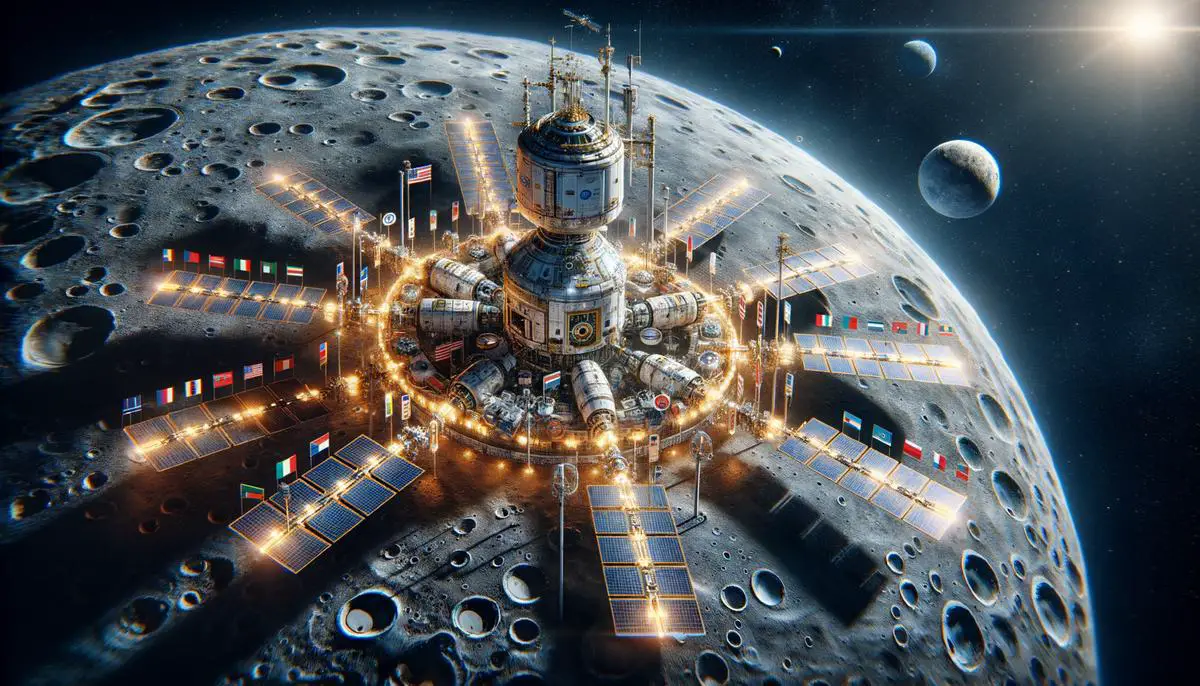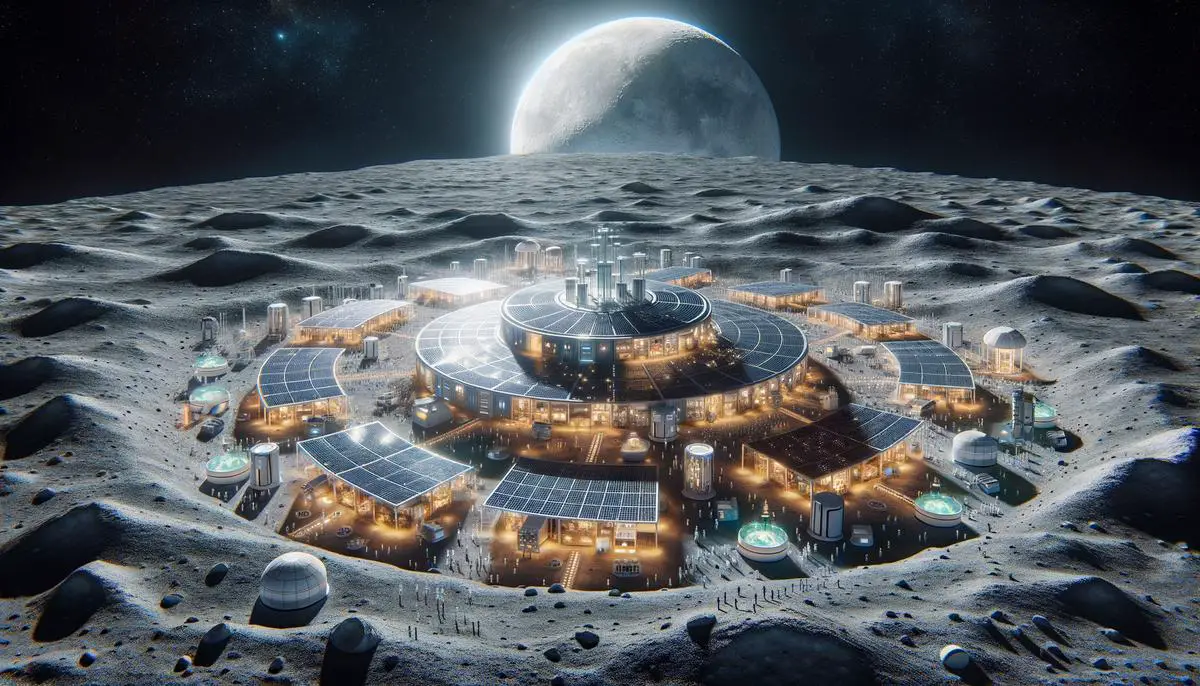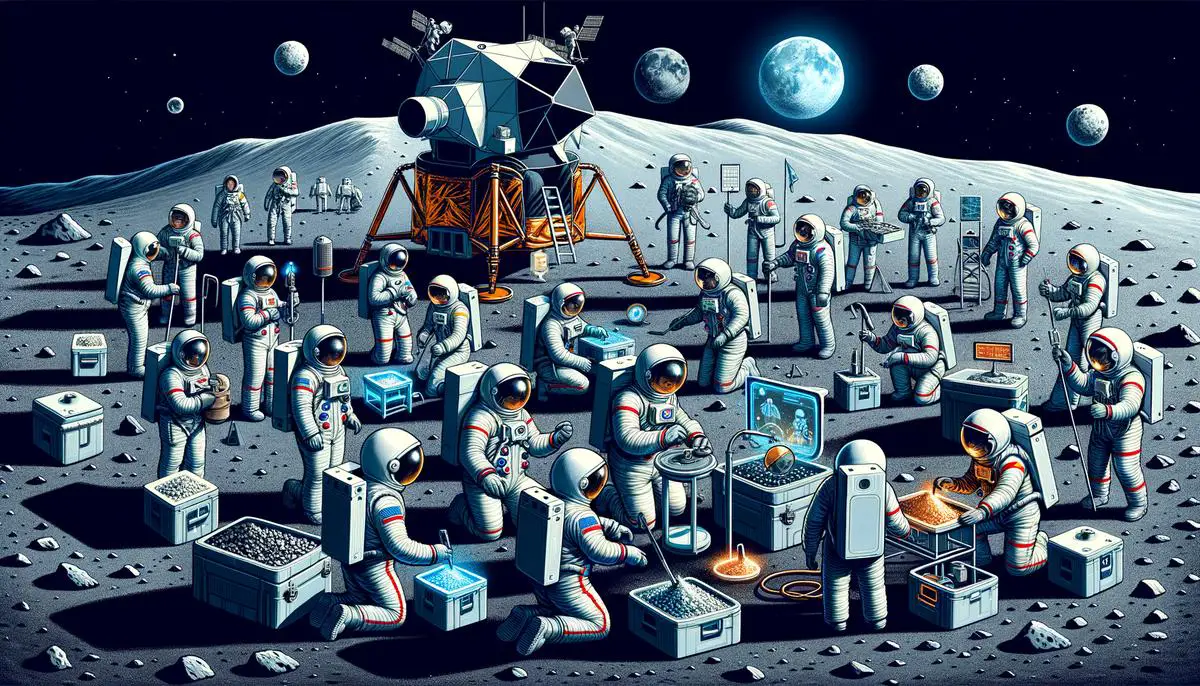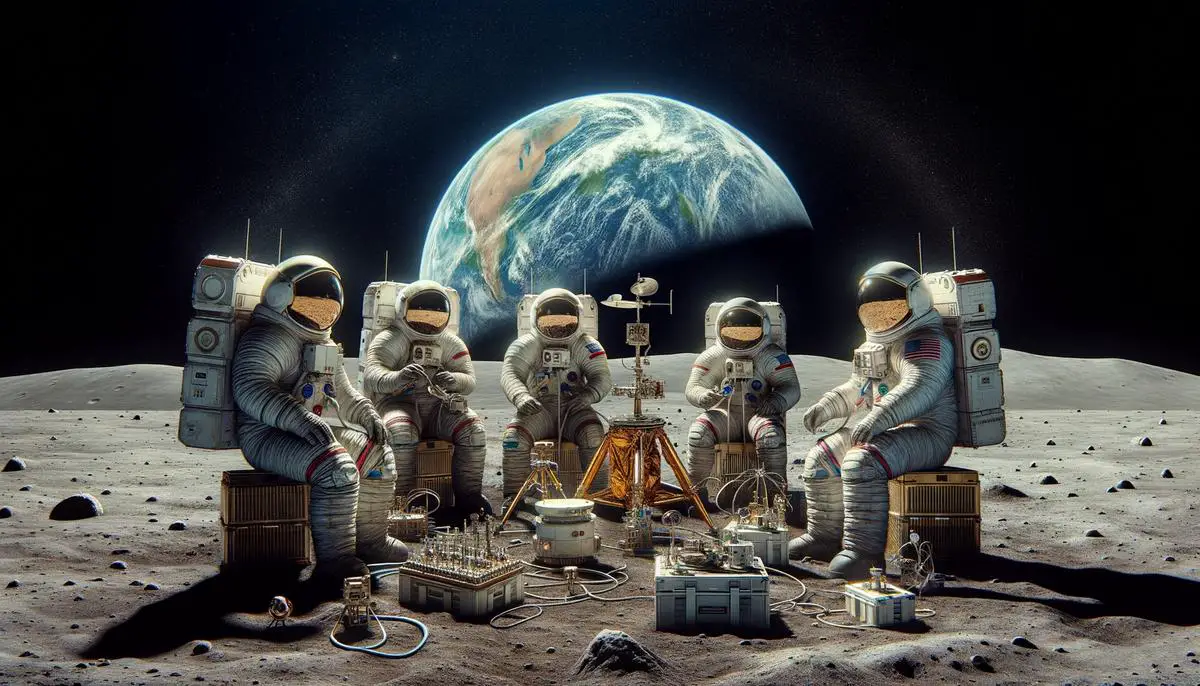NASA's Artemis program sets a new standard in human space travel, aiming to establish a sustainable presence on the Moon. This initiative represents a significant step towards extended off-Earth habitation and embodies the spirit of inclusivity and innovation in modern space exploration. With a focus on the future, Artemis prepares humanity for its next major milestone, fostering a deeper understanding of living and working in space.
Contents
- 1 Artemis Overview
- 2 SLS and Orion
- 3 Lunar Gateway
- 4 Human Landing System
- 5 Lunar Resources
- 5.1 Mining the Moon: Unlocking Lunar Resources for Sustainable Living
- 5.2 Hydrating the Future: The Quest for Lunar Water Ice
- 5.3 Sungazing & Power Plays: Harnessing Lunar Sunlight
- 5.4 Putting Moondust to Work: In-Situ Resource Utilization (ISRU)
- 5.5 Towards a Lunar Utopia: The Blueprint for Sustainability
- 6 Artemis Crew and Missions
Artemis Overview
NASA's Artemis program aims to not just revisit the Moon but to establish a lasting presence. Astronauts will leave footprints on the lunar surface as part of preparing for even bigger leaps, possibly to Mars. It's a new chapter in human space exploration, focused on learning how to live and work off-Earth for extended periods.
Artemis plans to send the first woman and the next man to the moon by its third mission, showcasing inclusivity and breaking barriers in space.
The Moon will serve as a waypoint on the journey to Mars. NASA's vision involves setting up a mini-station, or Gateway, in orbit around the Moon, acting as a cosmic laboratory and staging point for future deep space missions.
Artemis missions will employ cutting-edge technology. The Human Landing System will transport astronauts from the Gateway to the moon's surface, while the Space Launch System (SLS), the most powerful rocket ever built, will propel humans into lunar orbit.1
Returning to the Moon is preparation for the ultimate goal—humanity's voyage to Mars. By mastering living on the Moon, astronauts will gain crucial survival skills and technologies needed for the Red Planet.
When a diverse crew steps onto the lunar south pole as part of Artemis 3, it will demonstrate international partnerships and innovation stemming from shared aspirations and cooperation, paving the way for footprints on Martian soil and milestones in how humanity explores, lives, and thrives in space.

SLS and Orion
Space Launch System – The Backbone of Artemis
The SLS is NASA's premier vehicle for the journey to the Moon. More than just a rocket, the SLS is designed to support lunar sustainability with its robust capabilities. Its lift capacity of over 27 metric tonnes to lunar orbit makes it well-suited for a variety of lunar missions.2
The SLS architecture is flexible enough for various missions – from crewed flights aboard Orion to delivering sizable payloads like Gateway modules and lunar landers. Its compartments, the Universal Stage Adapter, unfold to hold and deploy payloads directly into lunar orbit.
This powerful rocket is designed to evolve, with variants capable of carrying more payload. It will be instrumental in establishing the Lunar Gateway and deploying the infrastructure necessary for long-term lunar habitation. With the SLS, a sustainable presence on the Moon becomes a realistic goal.
Orion Spacecraft: Designed for Lunar Missions
The Orion spacecraft ensures astronauts' safe passage to space. Orion is equipped with the systems and supplies needed for missions to the Moon.
Built for endurance, Orion features a service module provided by the European Space Agency. This module includes propulsion, power, and life support systems, enabling long-term missions.3
Orion's design incorporates sustainability features. It recycles water, filters carbon dioxide, and utilizes solar power with its expansive wings, demonstrating that living off-planet can mirror sustainable practices on Earth.
The SLS, with its significant lift capability, combined with Orion's advanced habitation features, forms a capable system for lunar missions. They serve as the foundation for NASA's plans to establish a sustainable presence on the Moon.

Lunar Gateway
As humanity ventures beyond Earth, setting sights on the Moon and eventually Mars, the Lunar Gateway serves as an essential outpost in lunar orbit. This versatile facility is crucial for sustainable deep space exploration.
The Lunar Gateway is a multifunctional space station. Orbiting the Moon, it will serve as a laboratory, living quarters, and staging point for lunar missions. It's where astronauts will prepare for descent to the lunar surface and conduct research.
The Gateway is equipped with innovative modules and compartments:
- The Power and Propulsion Element that keeps things running
- The Habitation and Logistics Outpost (HALO) providing crew quarters
International partners are contributing as well:
- Japan offers storage units and tech contraptions
- Canada provides a versatile robotic arm
- ESA supplies the reliable service module
The Lunar Gateway is pivotal for sustainable lunar living. It acts as a test bed for utilizing lunar resources while keeping astronauts comfortable in orbit. The Gateway is a laboratory where resources discovered on the moon's surface can be experimented with, filling knowledge gaps and paving the way for Mars colonization.4
The Lunar Gateway epitomizes international cooperation. Its assembly requires precision, trust, and global teamwork, underlining the message that exploring the unknown is a collective endeavor.
This outpost enables a continuous human presence in lunar orbit. Robotic missions can smoothly take over, employing the Gateway as their command center, ensuring uninterrupted scientific discovery and resource scouting.
The Lunar Gateway is a critical component of NASA's plans for sustainable lunar exploration. It brings together international partnerships, innovations, and sustainable practices to support a new era of lunar missions and prepare for the journey to Mars.

Human Landing System
The Human Landing System (HLS) is a critical component of the Artemis program, allowing astronauts to land on the lunar surface. It's a key part of NASA's goal for sustainable Moon exploration, where lunar missions become more frequent and routine.
The HLS differs significantly from the Apollo Lunar Module; it's designed to be reusable and capable of supporting multiple lunar missions. Its design and operation are managed by SpaceX and Blue Origin, representing a collaboration between NASA and modern aerospace companies to enable future lunar exploration.
Designing Dexterity: The Nuts and Bolts of Sustainable Moon Jumps
The HLS's design philosophy focuses on versatility and sustainability – two important aspects for the Artemis program. Artemis requires a system that enables frequent round-trips to the Moon, similar to current low earth orbit operations. The HLS incorporates SpaceX's expertise in reusable technology and Blue Origin's vision for a sustainable presence beyond Earth.
With systems focused on autonomy and reusability, the HLS aims to make lunar missions more accessible. Its operational design is intended to withstand the challenges of space travel and moon landings, extending the concept of vehicle longevity to the Moon. Sustainable practices, such as using lunar resources, are key to enabling long-duration lunar exploration.
The Beckoning Contribution of Commercial Partners
SpaceX's lunar variant of Starship aims to provide spacious accommodations with its substantial payload capacity. Despite some schedule delays, SpaceX remains committed to making Starship a regular visitor to the Moon, building on the reusability success of the Falcon 9.
Blue Origin's Blue Moon lander is designed for precision and sustainability, aiming to land on the Moon's surface with the skill of an experienced operator. With a focus on longevity and payload capabilities, Blue Moon contributes to supporting more astronauts for extended stays on the lunar surface.
Together, Starship and Blue Moon represent a new chapter in lunar missions, characterized by sustainability, reusability, and a renewed spirit of exploration.
It Starts with a Step: HLS and the Sustainable Dream
The HLS is a significant achievement, embodying the ambitions of the Artemis program. By integrating technology designed for repeated lunar travel and fostering partnerships that enable innovative solutions, it represents a bold approach to space exploration.
As astronauts land on the lunar surface using the HLS, it will signify progress towards a sustainable future, where humanity's space exploration efforts are enhanced by numerous lunar missions.
From its design focused on reusability to its role in facilitating collaborations, the HLS is an integral part of the Artemis program's vision for sustainable lunar exploration. It's our means of establishing the Moon as our second cosmic home, ready for regular lunar visits.

Lunar Resources
Mining the Moon: Unlocking Lunar Resources for Sustainable Living
As we prepare for sustainable living beyond Earth, the Moon serves not only as a stepping stone but also as a valuable resource. Modern space explorers are searching for water ice and abundant solar energy. The Moon is more than just a celestial body; it's a potential hub that can support human colonization efforts with its own resources. Let's explore the utility of lunar resources for sustainable living.
Hydrating the Future: The Quest for Lunar Water Ice
The search for water ice is a central focus of lunar sustainability strategies. This valuable resource is believed to be present in the Moon's permanently shadowed regions. Water ice on the Moon is a crucial discovery for sustainable space exploration. Why is frozen water so important? Water is essential for life support and can also be used to produce rocket fuel.
By splitting water into hydrogen and oxygen, it can provide breathable air and propellant for spacecraft.1 This makes the Moon a potential refueling station, supporting a cislunar economy where missions can be self-sustaining.
Sungazing & Power Plays: Harnessing Lunar Sunlight
Sunlight, often taken for granted on Earth, is a valuable resource for lunar inhabitants. Certain areas near the Moon's poles receive nearly continuous sunlight, making them ideal locations for solar power generation.
Solar arrays installed in these regions could generate electricity for local needs and to support various lunar operations, from maintaining habitats to powering mining and research equipment. With minimal atmospheric interference, solar power on the Moon has the potential to be a reliable and efficient source of clean energy.
Putting Moondust to Work: In-Situ Resource Utilization (ISRU)
As we envision settlements on the Moon, lunar regolith, or moondust, becomes an important resource. More than just dust, this material contains minerals and elements that can be used for construction, manufacturing, and potentially even agriculture on the Moon.
Through ISRU techniques, moondust could be processed into building materials for habitats and shielding against radiation and micrometeorite impacts.2 The ability to 3D print structures using local lunar materials opens up possibilities for self-sufficient lunar development.
Towards a Lunar Utopia: The Blueprint for Sustainability
The establishment of a human presence on the Moon represents a fusion of scientific ambition and practical sustainability. This eco-centric approach to lunar exploration demonstrates humanity's resourcefulness when faced with significant challenges. By utilizing resources like water ice, sunlight, and regolith, we can establish a sustainable presence on another world.
This model of sustainability also introduces an ethical framework for responsible use of space resources. As future lunar expeditions shape the Moon's development, they will strive to balance the utilization of resources with the need for conservation.
By combining ambition with accountability through innovations in the Artemis program and beyond, humanity's legacy in space has the potential to be one of thriving beyond Earth with foresight, responsibility, and a strong commitment to sustainability. The future of lunar exploration looks bright as we work towards establishing a long-term human presence on our celestial neighbor.

Artemis Crew and Missions
Star Voyagers: Meet the Trailblazers of the Artemis Odyssey
As we write the next chapters in our space exploration journey with the Artemis program, a group of exceptional individuals prepares to take on the challenge of lunar missions. They are pioneers, visionaries, and some of the most courageous people of our time, ready to make their mark on the Moon. The Artemis astronauts are a diverse team, selected for their skills, bravery, and potential to carry out humanity's lunar ambitions. Let's highlight these space explorers and the missions that await them.
Casting for the Moon: The Artemis Astronaut Selection Saga
NASA's astronaut selection process for Artemis missions is highly rigorous and demanding. The agency searched its ranks for individuals who embody the spirit of inclusivity and exploration that Artemis represents. NASA turned the call for astronauts into an opportunity to showcase the future of space exploration. The selected individuals will be human representatives on another celestial body, making history with every step they take on the lunar surface.
The Legions of Luna: Artemis' Envoy Astronauts
The Artemis generation of astronauts represents a diverse mix of experience, backgrounds, and stories. For Artemis 2, the crew includes:
- Commander Reid Wiseman
- Victor Glover as the pilot
- Mission specialists Christina Koch and Jeremy Hansen
This crew demonstrates international cooperation, with Hansen representing the Canadian Space Agency.
These notable figures are more than just explorers; they are the leaders of a new era. Each brings a unique set of experiences and expertise, contributing to the foundation for sustainable living beyond Earth.
Moonward Bound: Charting the Artemis Missions
Artemis 2 marks the beginning of humanity's return to the Moon, with a mission to orbit the Moon and return to Earth. It will test the capabilities of the crew and spacecraft, setting the stage for future sustainable deep space exploration.
Artemis 3 aims to land on the lunar south pole, a region thought to contain water ice and other valuable resources.3 This mission seeks to demonstrate the potential for utilizing lunar resources, moving towards self-sufficiency in space exploration.
Artemis 4 and 5 will build upon the achievements of previous missions, expanding infrastructure such as the Gateway and validating technologies for in-situ resource utilization (ISRU). These missions will work towards establishing a sustainable human presence on the Moon, whether by searching for water ice or testing life support systems capable of creating Earth-like conditions using lunar resources.
Orchestrating Sustainability: Beyond Footprints & Flagpoles
Each Artemis mission is carefully planned, combining technological advancements with human ingenuity and the aspiration to become a multi-planetary species. From Artemis 2's lunar orbit to the long-term goal of sustainable human presence on the Moon, every aspect aims to redefine our relationship with our celestial neighbor.
Artemis goes beyond exploration; it represents sustainability and international cooperation as we recognize our shared destiny in space. As these astronauts prepare for their lunar missions, armed with knowledge and a collective human spirit, their stories will not only be recorded in history books but will also serve as a testament to our shared celestial ambitions and responsibilities. Their legacy will be defined by how they paved the way for a sustainable future in space—the beginning of humanity's enduring relationship with the cosmos awaits with Artemis.

The Artemis program represents a significant milestone in human space exploration, going beyond the scope of traditional space missions. It's not just about leaving footprints on the lunar surface but about establishing a foundation for future generations to live and work in space. As we stand at the threshold of this new era, Artemis offers the potential to turn the vision of sustainable lunar living into a reality, ensuring that our space exploration efforts continue with determination and clear objectives.
